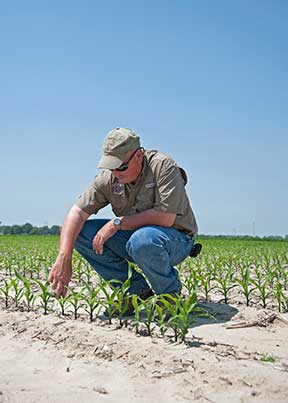News
The information presented on this page may be outdated. It may refer to situations which have changed or people who are no longer affiliated with the university. It is archived as part of Mississippi State University's history.
Seed treatments can reduce pest battles as crops grow

Corn, cotton and soybean producers have to strike a balance between risk prevention and wise spending to achieve good profits each year. (Photo By: Kat Lawrence)
2/20/2015
By: Robert Nathan Gregory
Insects that feed on recently planted crops can substantially reduce yields, but planting seeds pretreated with insecticides is one method of controlling these early-season pest problems.
Don Cook, an entomologist with the Mississippi Agricultural and Forestry Experiment Station, said corn and soybean insecticidal seed treatments have been used routinely in the state for the last decade.
"At-planting treatments in general have value to our growers," said Cook, who is based at the MSU Delta Research and Extension Center in Stoneville. "They have a positive effect on early-season insect management in corn, especially seedling pests that attack above and below ground."
More pests tend to feed under the ground on roots or right at the surface rather than above ground, Cook said. Insects such as seed corn maggots, Southern corn rootworms, wireworms and white grubs feed on roots below the soil surface. Cutworms feed on young plants above the soil surface, but they hide in soil and plant residue, making them difficult to spot.
From the time corn is planted until stalks are 1 foot tall, the crop is more susceptible to injury from early-season insects, possibly resulting in plant death. With less severe injury, plants can look normal for a time before injury symptoms begin to appear.
"Because many of the early-season insect pests feed below the ground, there is no rescue treatment," Cook said. "You can't come back and apply something to deal with them because by then, the yield potential of the injured plants has already been reduced. They have to be addressed at the time you begin planting."
Cook said virtually all corn seed planted now is pretreated, but certain field conditions may warrant additional protection, which means more money on the front end for the producer. Determining the right amount of protection is usually based on a field's pest problem history.
"You have to consider whether a field has had a history of pest problems every year," Cook said. "It used to be a question of whether or not you used a seed treatment. Now, it's about which one you want. Some people buy corn with low rates of treatment, but they'll supplement it with a granular or a liquid. Some will go to a midrate treatment."
Angus Catchot, an Extension row-crops entomologist, said MSU researchers have compiled data from 73 replicated trials using different insecticide treatments in Mississippi from 2005 to 2014. These studies indicate that pretreated seeds are effective at whatever level of treatment a producer chooses for a field.
In 2005, MSU researchers began testing "neonicotinoid" seed treatments for soybeans, which use a class of insecticides that affect the central nervous systems of insects. Since that time, the scientists have seen soybean yields increase by an average of 2.5 bushels per acre because of these treatments.
Since seed treatments were first commercially used in Mississippi in 2007, about 90 percent of soybean farmers across the state use them when planting their fields, Catchot said.
"One of the things we think seed treatments have done is remove the risk of replants," he said. "We've observed steady yield increases in recent years, and some of that is due to widespread use of seed treatment. Any time you lose a stand, you lose yield potential. Seed treatments stabilize our yields to some degree and minimize the amount of replanting we have to do."
View More News